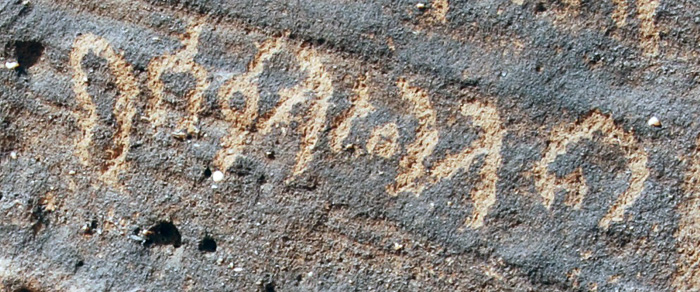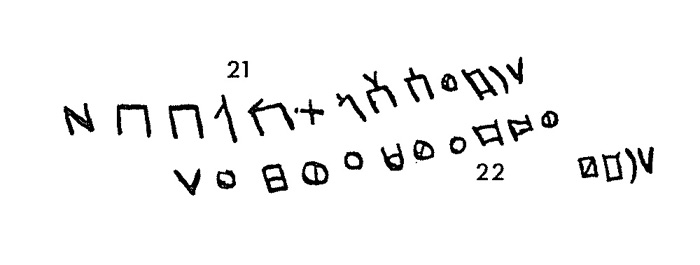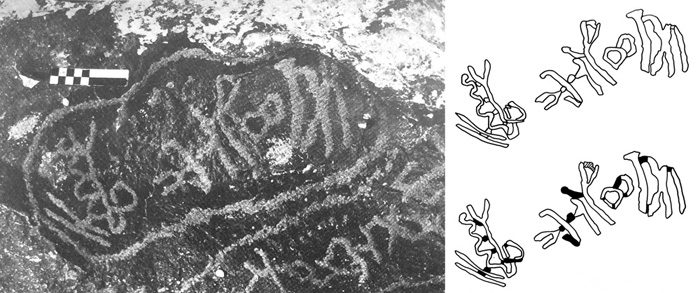Examples of writing
Dadanitic

Source: Jaussen, Antonin J., Savignac, Raphael M., Mission archéologique en Arabie. II. El-ʿEla, d'Hégra à Teima, Harrah de Tebouk (Publications de la Société française des fouilles archéologiques, 2), 1914, Paris: Librairie orientaliste Paul Geuthner, pl. LXXXII
JS Lih 49
1 ʿbdwd
2ʾfkl W-
3 d w-bn-h
4 S¹lm w-Z-
5 dwd hw-
6 dqw h-ġ-
7 lm S¹lm h-
8 [m]ṯlt l-
9 ḏ-Ġbt
10 f-rḍy
11 [… …]
1 ʿbdwd
2 priest of Wadd
3 and his sons
4 S¹lm and Z-
5 dwd
6 offered this
7 three year-old (?)
8 young boy S¹lm
9 ḏ-Ġbt;
10 and may ḏ-Ġbt favour (them)
11 [… …]
Inscription in relief on a stone block from Khirbet al-Khurayba but reemployed as a lintel of a door in the village of al-ʿUlā (Saudi Arabia). The text is read from right to left and has word dividers in the shape of two short strokes drawn on the top and bottom of the line. The script is characterised by perpendicular vertical strokes of the squared letters (ʾ, b, k etc.), rhomboid shape of the rounded letters (ʿ, w, y), m with closed triangles.
Dadanitic

Source: Jaussen, Antonin J., Savignac, Raphael M., Mission archéologique en Arabie. II. El-ʿEla, d'Hégra à Teima, Harrah de Tebouk (Publications de la Société française des fouilles archéologiques, 2), 1914, Paris: Librairie orientaliste Paul Geuthner, pl. LXXX
JS Lih 45
1 ʿbdḫrg bn Flh Zdḏġbt bn(y) h-
2 kfr l-h w-l wrṯ-h h-kfr ḏ-hkll-h
3 w-ʾḫḏ h-mṯbrn s¹nt ṯtn l-Tlmy bn H-
4 (nʾs¹)
1 ʿbdḫrg son of Flh (from the family) Zdḏġbt built this
2 tomb for himself and his descendants, the tomb that he completed as a whole;
3 and he took possession of these two sepulchral chambers, in the second year of Tlmy son of H-
4 nʾs¹.
Inscription in relief on a stone block reemployed as a door lintel in the village of al-ʿUlā (Saudi Arabia). The text, bearing four lines, is read from right to left and has word separators in the shape of vertical strokes. The script is characterised by oblique vertical strokes of the squared letters (ʾ, b, k etc.), circular shape of the rounded letters (ʿ, w, y), m open at the bottom, g in the shape of two open triangles.
Dadanitic

Source:
http://krcfm.orient.ox.ac.uk/fmi/webd#ociana
AH 001
1 Bn[w]d w-Whbʾm w-ʿ−
2 wd w-Lbʾm bnw |
3 S¹ʿdʾl ʾẓ−
4 llw ẓll h-nq l-
5 ḏ-Ġbt f-rḍ-hm
1 Bnwd, Whbʾm, ʿ−
2 wd and Lbʾm sons of
3 S¹ʿdʾl performed
4 the “ẓll” ceremony of the top of the mountain for
5 ḏ-Ġbt; and (ḏ-Ġbt), favour them.
Inscription incised on a rock at the gorge of al-ʿUdhayb, near al-ʿUlā (Saudi Arabia). The text, bearing five lines, is read from right to left and has word separators in the shape of vertical strokes. The script is characterised by perpendicular vertical strokes of the letter b, but oblique vertical strokes for the other squared letters (ʾ, s¹, ġ), circular shape of the rounded letters (ʿ, w), m open at the bottom.
Dadanitic

Source:
http://krcfm.orient.ox.ac.uk/fmi/webd#ociana
U 100
1 Fhd h-Qs¹m
1 Fhd, the oracle priest
Graffito incised on a rock at the gorge of al-ʿUdhayb, near al-ʿUlā (Saudi Arabia). The text, bearing one line, is read from right to left and has a word separator in the shape of a short vertical stroke.
Taymanitic

Source: Eskoubi, Khaled M., Dirāsa taḥlīlīya muqārina li-n-nuqūš min minṭaqat (Ramm) ǧanūb ġarb Taymāʾ, 1999, al-Riyāḍ: Wazārat al-maʿārif (wakālat al-āṯār wa-l-matāḥif), p. 237
Taymāʾ 1=ESKTay 169
1ʾn Mrdn ḫlm Nbnd mlk Bbl
2 ʾtwt mʿ rbs¹rs¹ Kyt
1 I am Mrdn, friend of Nabonidus king of Babylon;
2 I came with chief Kyt.
Inscription engraved on rock, from the area of Ramm, southwest of Taymāʾ (Saudi Arabia). The document can be dated to the middle of the 6th c. BC thanks to the mention of Nabonidus, king of Babylon (556-539 BC). The two-line text is read from right to left and has word dividers in the shape of a little apostrophe drawn on the top.
Taymanitic

Source: Eskoubi, Khaled M., Dirāsa taḥlīlīya muqārina li-n-nuqūš min minṭaqat (Ramm) ǧanūb ġarb Taymāʾ, 1999, al-Riyāḍ: Wazārat al-maʿārif (wakālat al-āṯār wa-l-matāḥif), p. 115
JS Tay 517=ESKTay 58
1 lm Ṣmdʿ b-Ṣmnʿm b-Ṯrbn ḥll b-z
1 By Ṣmdʿ son of Ṣmnʿm son of Ṯrbn; he camped in this (place).
Inscription engraved on rock, from the area of al-Khabu al-Sharqi, some km southwest of Taymāʾ (Saudi Arabia). The one-line text is read from right to left and has word dividers in the shape of dots drawn on the top.
Taymanitic

Source: Winnett, Frederick V., Reed, William L., Ancient Records from North Arabia (Near and Middle East Series 6), 1970, Toronto: University of Toronto, p. 223.
WR Tay 20
1 Bhs²rkt nṣr b-ḍr Ddn yrẖ l-Ṣlm
1 Bhs²rkt guarded for Ṣlm during the war with Dadan for one month.
Inscription engraved on rock, from the area of Jabal Ghunaim, 14 km south of Taymāʾ (Saudi Arabia). The two-line text with no word dividers begins on the right lower side and continues towards the left in a clockwise direction.
Dumaitic

Source: Winnett, Frederick V., Reed, William L., Ancient Records from North Arabia (Near and Middle East Series 6), 1970, Toronto: University of Toronto, p. 207, 216.
WR Dum 21
1 h-Rḍw s¹ʾlt Klb b-z
1 Oh Rḍw, the request of Klb is here!
Inscription from Sakāka, some km northeast of the oasis of Dūmat al-Jandal (Saudi Arabia). The text is read from right to left and has no word dividers.
Dumaitic

Source: Winnett, Frederick V., Reed, William L., Ancient Records from North Arabia (Near and Middle East Series 6), 1970, Toronto: University of Toronto, p. 207, 216.
WR Dum 22
1 h-Rḍw w-Nhy w-ʿtrs¹m s¹ʿdn ʿl wddy
1 Oh Rḍw, Nhy and ʿtrs¹m, help me concerning my love!
Inscription from Sakāka, some km northeast of the oasis of Dūmat al-Jandal (Saudi Arabia). The text is read from right to left and has word dividers in the shape of vertical strokes having a variable length.
Thamudic B

Source: Al-Jallad, Ahmad, Al-Manaser, Ali, A Thamudic B abecedary in the South Semitic letter order, in A. M. Butts (ed.), Semitic languages in contact, 2015, Leiden: Brill, p. 1-15, figs. 1-2.
Al-Jallad Al-Manaser 2015, 1
h l ḥ m q w s2 r b t s1 k n ḫ ṣ ṯ f ʾ ʿ ḍ
Abecedary in Thamudic B engraved on a stone in the shape of an obelisk with two other graffiti in the same script, from wādī al-Ḥašād, near aṣ-Ṣawāfī (northeastern Jordan). The abecedary follows the order of the south Semitic script family (called halḥam), though with some slight differences. This is the first abecedary known in Thamudic. Abecedaries are known in Dadanitic (south Semitic order), Hismaic (northwest Semitic order) and Safaitic (particular sequence, probably of a mnemonic type).
Thamudic D

Source: Healey John F., Smith, G. Rex, The earliest dated Arabic document (A.D. 267), ATLAL 12, 1989, p. 77-84, pl. 46.
JSTham 1
1 zn Rqs² bnt ʿbdmnt
1 This is (the tomb of) Rqs² daughter of ʿbdmnt
Inscription in Thamudic D incised as a gloss to the text JSNab 17, from Madāʾin Ṣāliḥ (Saudi Arabia). JSNab 17, written in Nabataean script and language, is an epitaph carved on the tomb of a woman who died in 162 (267 AD). The Thamudic text is read from the top to the bottom, and has a style that appears archaic. Compared to the other varieties of Thamudic scripts, D is characterised by the letter s² in the shape of a radiated sun and not of a zigzag line.
Thanks to the dating in the main inscription, this is one of the few ANA texts with a chronological reference.
Southern Thamudic (Himaitic)

Source: Robin, Christian J., Gorea, Maria, in I. Finkelstein, Ch. Robin, Th. Römer (eds.), Alphabets, texts and artifacts in the Ancient Near East. Studies presented to Bejamin Sass, 2016, Van Dieren, pl. 2.
Robin Gorea Hima pl. 2
1 Nmrt wdd ḏ-Fḍlmnt
1 Nmrt loves ḏ-Fḍlmnt
Graffito from the area of Ḥimā, in the desert north of Najrān. The text has one line and is read from the right to the left. The script is a variety of southern Thamudic, which has been recently isolated and defined as Himaitic. In the text, some of its typical glyphs can be recognised: the m and d are similar to those in Thamudic B, the ḏ is identical to the ancient south Arabian one, while the ḍ has an unknown form in the shape of a double trident.
Southern Thamudic (Himaitic)

Source: Saudi-French Archaeological and Epigraphic Mission to Najran (MAFSN).
SMA04.01 no. 5
1 s¹ṭr
2 ʿbdyġṯ
1 ʿbdyġṯ
2 wrote (this)
Graffiti in Himaitic Thamudic accompanied by a drawing of a camel, engraved on a rock near Ḥimā, north of Najrān (Saudi Arabia).
Hismaic

Source: Hayajneh, Hani, Ancient North Arabian–Nabataean bilingual inscriptions from southern Jordan, Proceedings of the Seminar for Arabian Studies 39, 2009, p. 203–222, figs. 3, 4.
Hayajneh 2009, 1
1 l ʿbdʾyb ḫṭṭ bkr
2 bn S¹ʿd
1 By ʿbdʾyb
2 son of S¹ʿd
1bis (in l. 1) carved a camel.
Inscription on rock found in wādī Ḥafīr, a canyon stretching for 15 km southwest of Rās an-Naqab, in the desert of Ḥismà (southern Jordan). The two-line text is read vertically from the top to the bottom; it is accompanied on its right by an almost identical version written in Nabataean script and language. On its left, there is the drawing of a camel with his rider, drawing which is recorded in the text.
Hismaic

Source: Hayajneh, Hani, Ancient North Arabian–Nabataean bilingual inscriptions from southern Jordan, Proceedings of the Seminar for Arabian Studies 39, 2009, p. 203–222, figs. 14, 15.
Hayajneh 2009, 6
1 l ʾdʿn bn Zd bn ʾdʿn w dʿʿ w ḏkrt Lt Yqm
1 By ʾdʿn son of Zd son of ʾdʿn, and he invoked (the goddess), and may Lat remember Yqm.
Inscription on rock found in Wādī Ḥafīr, a canyon stretching for 15 km southwest of Rās an-Naqab, in the desert of Ḥismà (southern Jordan). The text begins on the upper right corner and moves towards the left, then continues towards the bottom and right boustrophedonically.
Hismaic

Source: Zayadine, Fawzi, Farès-Drappeau, Saba, Two North-Arabian inscriptions from the temple of Lât Wadi Iram, Annual of the Department of Antiquities of Jordan 42, 1998, p. 255-258, figs. 3-4.
Zayadine-Farès Drappeau 1998
1 l Ġṯ bn ʾs¹lh bn Ṯkm w bny bt Lt ḏ ʾlʿḏ
1 By Ġṯ son of ʾs¹lh son of Ṯkm; and he built the temple of Lat at al-ʿAḏ.
Inscription from Wādī Rāmm (southern Jordan). It is engraved on a stone found in the cellar of the temple of the goddess Lat, construction that is recorded in the text. The text begins in the upper right corner and continues boustrophedically.
Hismaeo-Safaitic

Source: Al-Salameen, Zayd, A new Ancient North Arabian inscription with a reference to the Nabataean king Aretas, Arabian Archaeology and Epigraphy 22, 2011, p. 215-218, figs. 2-3
al-Salameen 2011 al-Ḥussayniah 1
1 l ʿqrb bn Ms¹k ḏ-ʾl ʿmrt w-ḥll s¹nt mt Ḥrṯt h-mlk
1 By ʿqrb son of Ms¹k of the clan ʿmrt; and he camped (here) in the year when king Ḥarithat died.
Inscription on rock from the surroundings of al-Ḥussayniah, north of Maʿān (southern Jordan). The text is in mixed Hismaic-Safaitic script: the letters ḏ and ṯ are typical of the first alphabet; the ḥ is of the second. The inscription begins on the lower left corner and continues in a spiral direction clockwise. It is closed by a symbol made of seven vertical strokes.
The text is dated according to the death of a Nabataean king. Four kings were named Ḥarithat (Arethas), who reigned from 168 BC to 40 AD. However, it remains difficult to know exactly which Ḥarithat was meant here.
Safaitic

Source: Macdonald, Michael C. A., Mu'azzin, Muna, Nehmé, Laïla, Les inscriptions safaïtiques de Syrie, cent quarante ans après leur découverte, Comptes rendus des séances de l'Académie des Inscriptions et Belles-Lettres 140, 1996, p. 435-494, figs. 18-19
LP 325
l Mṭr bn ʿm bn Mṭr bn ʾnʿm bn Qdm ḏ ʾl ʿwḏ w dmy l-h ʾb-h w ḫrṣ h-nw mʿ ʾḫ-h m-mdbr f h Lt s¹lm w ġnmt l-ḏ dʿy h-s¹fr w ʿwr w ḫrs¹ l-ḏ yʿwr h-ḫṭṭ
By Mṭr son of ʿm son of Mṭr son of ʾnʿm son of Qdm of the clan of ʿwḏ; and his father drew (an image) for him while he kept watch with his brother for the migrating group from the inner desert; so, O Lat, may he who would read this writing aloud have security and favour, but let there be blindness and dumbness on him who would efface this writing.
Inscription on rock from al-ʿIsawi, near Namāra (southeastern Siria). The text begins on the upper right corner and continues counter clockwise around the drawing of a horse rider, a camel, a dromedary and a second, probably female, human figure. The style of the text is mixed between the normal and the square style, the latter only found in the initial part of the text containing the genealogy.
Safaitic

Source: Macdonald, Michael C. A., Cursive Safaitic inscriptions? A preliminary investigations, in M. M. Ibrahim (ed.), Arabian Studies in Honour of Mahmoud al-Ghul: Symposium at Yarmouk University December 8-11 1984, Harrassowitz: Wiesbaden, 1989, p. 62-70, pl. 2a, fig. 1.
MRA 1
l Ḫzb bn Hdrs¹ bn Hs²ll
1 By Ḫzb son of Hdrs¹ son of Hs²ll
Inscription on rock from Rasm ʿAmīri (northeastern Jordan). The text is read from right to left and shows ligatures between the letters in the shape of dot or short stroke. Moreover, the first of the two nouns bn is written as a monogram. In Safaitic there are several examples of ligatures, which however are purely due to the aesthetics and tastes of the authors, rather than to the wish of writing in cursive script.
Safaitic

Source: Rawan, S. Neue safaitische Inschriften aus Süd-Syrien. (Semitica et Semitohamitica Berolinensia, 16). Aachen: Shaker, 2013.
RSIS 351
l s¹ḫr bn ʿbd bn ʾdm bn ms¹k bn s²rb w ḏkr ḍr w bky ʿ[l]- ʾb -h w [ʿl-] ʿbd w dd -h f wlh ʿl- ḏ ḍr f tfqd w s²ty ḥrt ʿwd w ḥl h- dr w nqʾt w grb l- ḏy yʿwr h- ḫṭṭ
By S¹ḫr son of ʿbd son of ʾdm son of Ms¹k son of S²rb and he remembered Ḍr and wept [for] his father and [for] ʿbd and his paternal uncle and so he was distraught over those who were harmed and were lost; and he spent the winter in the Ḥarrah again and camped in this place and may he who would efface this carving have scabies and be thrown out of the grave.
Inscription on stone coming from Tall aḍ-Ḍabiʿ (Syria). The text begins on the upper right angle, runs right-to-left and continue boustrophedically on three lines. Other texts are engraved on the same stone.
Safaitic

Source: Al-Jallad, A.M An Ancient Arabian Zodiac. The Constellations in the Safaitic Inscriptions. Part II. Arabian Archaeology and Epigraphy 27, 2016: 84–106. Pages: 98.
K 169
l nʿrt bn ḫdmt bn trml bn s¹ry bn s¹hm w ġz b- nḫl f h yṯʿ s¹lm w klʾ h- s¹my ḥḍ{r} mlḥ f ḏ{k}{r} f ʾmt f yʾs¹ f h bʿls¹mn r{w}ḥ w s¹lm
By Nʿrt son of Ḫdmt son of Trml son of S¹ry son of S¹hm he was on a raid in a valley and so, O Yṯʿ, may he be secure and the sky withheld its rain during [the sun's] presence in Aquarius then Aries then Libra, and so he despaired so, O Bʿls¹mn, [grant] relief and security.
Inscription on stone coming from the region of al-Mafraq (Jordan). The text begins on the upper right angle, runs right-to-left and continue boustrophedically on five lines.